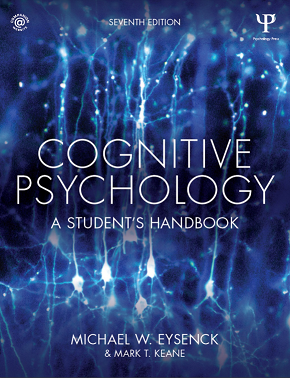
e-BOOK
Cognitive Psychology: A Student’s Handbook
It is almost as pointless to ask, “When did cognitive psychology start?”, as to enquire, “How long is a piece of string?” However, the year 1956 was of crucial importance. At a meeting at the Massachusetts Institute of Technology (MIT), Noam Chomsky gave a paper on his theory of language, George Miller discussed the magic number seven in short-term memory (Miller, 1956) and Newell and Simon discussed their extremely influential model called the General Problem Solver (see Newell et al., 1958). In addition, there was the first systematic attempt to study concept formation from a cognitive perspective (Bruner et al., 1956). At one time, most cognitive psychologists subscribed to the informationprocessing approach based loosely on an analogy between the mind and the computer. A version of this approach popular in the 1970s is shown in Figure 1.1. A stimulus (an environmental event such as a problem or a task) is presented. This causes certain internal cognitive processes to occur, and these processes finally produce the desired response or answer. Processing directly affected by the stimulus input is often described as bottom-up processing. It was typically assumed that only one process occurs at any moment in time. This is serial processing, meaning the current process is completed before the next one starts. The above approach is drastically oversimplified. Task processing typically also involves top-down processing. Top-down processing is processing influenced by the individual’s expectations and knowledge rather than simply by the stimulus itself. Read what it says in the triangle shown in Figure 1.2. Unless you know the trick, you probably read it as, “Paris in the spring”. If so, look again and you will find the word “the” is repeated. Your expectation that it was a well-known phrase (i.e., top-down processing) dominated the information available from the stimulus (i.e., bottom-up processing).
Ketersediaan
| 114 | 150 | Website | Tersedia |
Informasi Detail
- Judul Seri
-
-
- No. Panggil
-
150
- Penerbit
- New York : Psychology Press., 2015
- Deskripsi Fisik
-
650 halaman
- Bahasa
-
Inggris
- ISBN/ISSN
-
978-1-315-77800-6
- Klasifikasi
-
150
- Tipe Isi
-
text
- Tipe Media
-
computer
- Tipe Pembawa
-
online resource
- Edisi
-
Seventh Edition
- Subjek
- Info Detail Spesifik
-
-
- Pernyataan Tanggungjawab
-
Michael W. Eysenck
Versi lain/terkait
Tidak tersedia versi lain
Lampiran Berkas
Komentar
Anda harus login sebelum memberikan komentar
 Karya Umum
Karya Umum  Filsafat
Filsafat  Agama
Agama  Ilmu-ilmu Sosial
Ilmu-ilmu Sosial  Bahasa
Bahasa  Ilmu-ilmu Murni
Ilmu-ilmu Murni  Ilmu-ilmu Terapan
Ilmu-ilmu Terapan  Kesenian, Hiburan, dan Olahraga
Kesenian, Hiburan, dan Olahraga  Kesusastraan
Kesusastraan  Geografi dan Sejarah
Geografi dan Sejarah